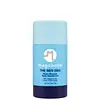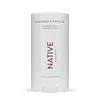What's inside
What's inside
 Key Ingredients
Key Ingredients

 Benefits
Benefits

 Concerns
Concerns

 Ingredients Side-by-side
Ingredients Side-by-side

Caprylic/Capric Triglyceride
MaskingTapioca Starch
Stearyl Alcohol
EmollientButyrospermum Parkii Butter
Skin ConditioningSodium Bicarbonate
AbrasiveMagnesium Hydroxide
AbsorbentCocos Nucifera Oil
MaskingTriethyl Citrate
MaskingHydrogenated Castor Oil
EmollientHelianthus Annuus Seed Oil
EmollientBehenyl Alcohol
EmollientPolyglyceryl-3 Stearate
EmulsifyingEucalyptus Globulus Oil
Cedrus Atlantica Bark Oil
MaskingZinc Ricinoleate
Zinc Oxide
Cosmetic ColorantXylityl Sesquicaprylate
AntimicrobialLactobacillus Ferment
Skin ConditioningSilica
AbrasiveKaolin
AbrasiveAvena Sativa Kernel Flour
AbrasiveCichorium Intybus Seed Oil
AntioxidantHippophae Rhamnoides Fruit Oil
Skin ProtectingTocopherol
AntioxidantMagnesium Ascorbyl Phosphate
AntioxidantMentha Piperita Oil
MaskingBenzyl Acetate
MaskingCitronellol
PerfumingHexyl Cinnamal
PerfumingMethyl Salicylate
PerfumingMethyl Benzoate
PerfumingCoumarin
PerfumingHydroxycitronellal
PerfumingCarvone
MaskingLinalool
PerfumingTerpineol
MaskingMaltodextrin
AbsorbentAnhydroxylitol
HumectantCitrus Aurantifolia Oil
CleansingCaprylic/Capric Triglyceride, Tapioca Starch, Stearyl Alcohol, Butyrospermum Parkii Butter, Sodium Bicarbonate, Magnesium Hydroxide, Cocos Nucifera Oil, Triethyl Citrate, Hydrogenated Castor Oil, Helianthus Annuus Seed Oil, Behenyl Alcohol, Polyglyceryl-3 Stearate, Eucalyptus Globulus Oil, Cedrus Atlantica Bark Oil, Zinc Ricinoleate, Zinc Oxide, Xylityl Sesquicaprylate, Lactobacillus Ferment, Silica, Kaolin, Avena Sativa Kernel Flour, Cichorium Intybus Seed Oil, Hippophae Rhamnoides Fruit Oil, Tocopherol, Magnesium Ascorbyl Phosphate, Mentha Piperita Oil, Benzyl Acetate, Citronellol, Hexyl Cinnamal, Methyl Salicylate, Methyl Benzoate, Coumarin, Hydroxycitronellal, Carvone, Linalool, Terpineol, Maltodextrin, Anhydroxylitol, Citrus Aurantifolia Oil
 Reviews
Reviews

Ingredients Explained
These ingredients are found in both products.
Ingredients higher up in an ingredient list are typically present in a larger amount.
This ingredient is also known as shea butter. It is an effective skin hydrator and emollient.
Emollients help soothe and soften your skin. It does this by creating a protective film on your skin. This barrier helps trap moisture and keeps your skin hydrated. Emollients may be effective at treating dry or itchy skin.
Shea butter is rich in antioxidants. Antioxidants help fight free-radicals, or molecules that may harm the body. It is also full of fatty acids including stearic acid and linoleic acid. These acids help replenish the skin and keep skin moisturized.
While Shea Butter has an SPF rating of about 3-4, it is not a sunscreen replacement.
Shea butter may not be fungal acne safe. We recommend speaking with a professional if you have any concerns.
Learn more about Butyrospermum Parkii ButterThis ingredient is an emollient, solvent, and texture enhancer. It is considered a skin-softener by helping the skin prevent moisture loss.
It helps thicken a product's formula and makes it easier to spread by dissolving clumping compounds.
Caprylic Triglyceride is made by combining glycerin with coconut oil, forming a clear liquid.
While there is an assumption Caprylic Triglyceride can clog pores due to it being derived from coconut oil, there is no research supporting this.
Learn more about Caprylic/Capric TriglycerideCocos Nucifera Oil is obtained from the kernels of the coconut fruit. In other words, this is coconut oil.
Coconut Oil is rich in fatty acids with lauric acid making up the majority of these. It also contains linoleic acid. Due to this high fatty acid content, coconut oil helps trap moisture and soften skin.
Despite being antibacterial, coconut oil may not be great for acne-prone skin. It is comedogenic and may clog pores. This ingredient may not be safe for malassezia or fungal acne.
Note: Coconut Oil should not replace your sunscreen for UV protection. Studies show it only blocks about 20% of UV.
This oil is non-volatile and has a light scent.
The term 'fragrance' is not regulated in many countries. In many cases, it is up to the brand to define this term. For instance, many brands choose to label themselves as "fragrance-free" because they are not using synthetic fragrances. However, their products may still contain ingredients such as essential oils that are considered a fragrance.
Learn more about Cocos Nucifera OilWe don't have a description for Magnesium Hydroxide yet.
Sodium Bicarbonate has a more famous name: Baking soda.
In cosmetics, it is used to adjust the acidity. Due to its white crystalline solid form, it can also be an abrasive (exfoliator).
This ingredient is water-soluble.
Learn more about Sodium BicarbonateTapioca starch is a thickening agent and is made from the cassava root, also known as yucca.
According to a manufacturer, it is an excellent talc replacement.
It is gluten-free.
Learn more about Tapioca Starch